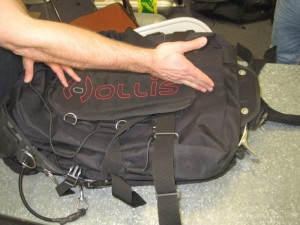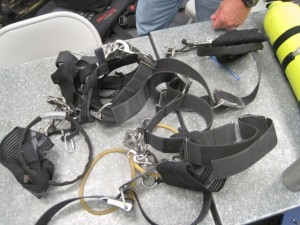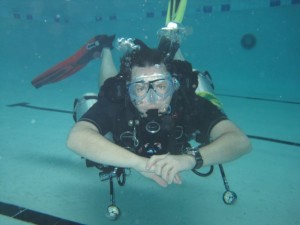2012 has been an interesting year for me. I completed EMT and Advanced EMT training, both to earn Utah credentials and to help maintain my Diver Medical Technician (DMT) certification. To end the year, though, I’ve started something new: PADI Sidemount scuba training.
Sidemount Scuba uses an equipment setup that was formerly reserved for Tec diving. Unlike traditional open-circuit scuba, with a tank mounted on your back, Sidemount keeps tanks streamlined along the sides of your body. This provides many benefits to the diver: better streamlining, better weight distribution, redundancy in gas supply and additional flexibility for your back. It takes a bit to get used to and it’s very gear-intensive, but sidemount has the possibility to open up scuba to divers that couldn’t otherwise tolerate a tank on their backs.
Let’s take a look at some of the differences in equipment setup. First the BCD has some features to allow mounting the tanks.
Then, you need rigging to attach the tanks to the BCD.
The tanks are rigged top and bottom with clips to attach to the BCD. Then there are bungees on the BCD to tighten and streamline the arrangement. Each tank has it’s own first stage. The left side has a shorter hose to the second stage and the primary inflator for the BCD. The right hose has a longer hose to facilitate air-sharing if your buddy runs out of air. To streamline and retain the longer hose (5-7 feet long), elastic bands are on the right tank to retain the hose. These can either be something a simple as some surgical tubing or brand-name elastic take bands. Each first stage also has an SPG (submersible pressure gauge) to monitor breathing gas. The SPG’s are on short hoses and they’re usually positioned so their within easy site while diving.
When diving with a pair of 80cf aluminum tanks, you’ve twice as much breathing gas as diving with a single tank. Alternatively, you can dive with two smaller tanks to provide the same amount of breathing gas. Either way, you’ve completely redundant tanks, first stages, SPG’s, and second stages. I’m looking forward to completing my initial Sidemount open water dives.
During the same trip to Dive Utah’s pool and while we had the sidemount gear all set up, we also completed the intro to Tec pool session. We repeated some of the same drills we completed for the Sidemount pool session, such as air sharing, hovering, etc. Added into this was doing a NOTOX breathing gas switch and putting up a lift bag.
All-in-all, starting both PADI Sidemount (recreational) and the DSAT TecRec programs has been a lot of fun. Always a good reminder that even after having a lot of training, taking additional training can always make you a better diver.
Safe Diving
–jon
UPDATE: I’m now a PADI Sidemount Specialty Instructor and Instructor Trainer. I’ve logged a lot of Sidemount dives since taking the course. If you’re ready to try a new gear configuration, contact me to take the PADI Sidemount Specialty.



